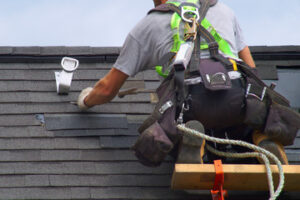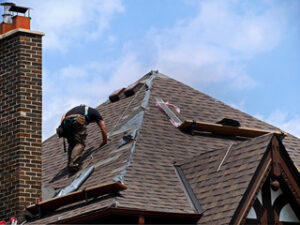Repair costs are influenced by the extent of damage, the type and design of roof and whether an insurance claim is involved. Often, repairs are more cost-effective than replacing a whole roof.

Regular maintenance is key to reducing roof repair expenses. A few preventive measures include trimming overhanging branches, installing adequate attic insulation and ensuring proper gutter drainage. Contact Montana Roofing Solutions for professional help.
There are a variety of reasons why roof tiles or shingles may become damaged. Weather conditions, animal activity (such as squirrels) or simply age and wear can all cause tiles to crack and break.
While a broken tile isn’t as obvious as a missing shingle, you should still inspect your roof regularly and replace any damaged tiles immediately. Not only will this prevent moisture from getting in, but it’ll also help keep your home warmer in the winter and cooler in the summer.
Shingles are less susceptible to damage than tiles, but a hail storm can leave them with gaps and holes in which water can seep. This can lead to moss, mold and other issues that can affect the structural integrity of your roof.
Replacing a single shingle is fairly easy, and depending on how comfortable you are on your roof, it’s something that you can do yourself if the repair doesn’t require you to access difficult-to-reach places. The trick is knowing where to nail a new shingle so it’s secure for the long haul, and this is typically something best left to the professionals.
Leaks are more common with shingled roofs, and while it’s possible for them to develop where there’s open area of uninterrupted shingles, it’s far more common for leaks to occur where items penetrate the roof such as plumbing and roof vents, chimneys or dormers. It’s also a good idea to check that the caulk around windows, corner boards and between window and siding is intact and not cracked or peeling, as this can allow water to dribble down and into the house.
Leaks don’t just damage the shingles and tiles, they can also affect the support beams and foundation of your home, leading to costly structural problems over time. This is why it’s important to check your roof after any significant weather events and take action as soon as you notice damage. It’s also why it makes sense to work with a professional roofing company for any repairs you need. They’ll be able to quickly and efficiently get the job done and ensure your roof is as water-tight as possible.
Leaks
A leaky roof can be a serious problem. Water damage not only can ruin ceilings, but it can also lead to mold and mildew problems in walls and other parts of the house. It’s important to fix any leaks as soon as you notice them to prevent the problem from getting worse.
Leaks are usually easy to spot inside the home, but locating their source on the roof can be difficult. Start by checking your attic on a rainy day, as this will reveal any areas where water is collecting. Look for stains on the ceiling or walls, and listen for dripping noises that may indicate a leak.
If you find a leaky area, shut off the water to that room and use a ladder to access the roof. Take a look at the flashing around the area to see if it is cracked or missing shingles. If you can’t find the source of the leak, use roofing tar to cover the area and secure it with plywood or shingles. This is only a temporary repair and should be done until you can call a professional for more permanent repairs.
Another good way to check for leaks is to inspect the roof from outside after it rains. This can be a simple job, depending on your skill level and how comfortable you are with heights. If you don’t want to climb a ladder, you can use binoculars from the ground or even a drone for a closer look. Look for any signs of leaks or other damage such as shingle debris, clogged gutters and downspouts, and rusty metal chimney flashing.
If you do notice water stains on the ceiling, don’t wait to contact a professional. Ignoring a leaky roof can lead to severe and expensive water damage and structural issues in the home. Fortunately, many leaks can be easily fixed if you know where to look and what tools to use. For the most serious leaks, it’s always best to call in a professional roofing contractor for proper diagnosis and roof repair.
Flashing Issues
Flashing is the metal material that is installed where your roof meets other surfaces, like chimneys or other walls and structures. It funnels water away from seams and transition points, but it can leak if it is damaged or not correctly fitted. A skilled roof repair expert can inspect the flashing and identify issues that need to be repaired. Flashing problems can lead to mold, wood rot and other serious damage to the underlying structure of your home. The longer these issues are ignored, the more expensive they can become.
Damage to flashing is commonly caused by exposure to the elements, including UV rays and extreme temperature changes. This causes the flashing to expand and contract, which can cause it to develop a wrinkled look that allows water to seep into the roof or walls of your house in the next rainstorm. It is also possible for the flashing to become loose, which can be a result of faulty installation or even foundation problems.
Typical signs of flashing failure include water stains on your ceiling or walls that align with the location of the leaking roof seam. The leaking area may also be accompanied by sagging areas of your roof, moisture stains and mildew. Other signs to watch for are rust and corrosion, which can be an indication that the flashing has been exposed to moisture for too long.
When a leaking roof seam is detected, the flashing should be removed, and a new piece of flashing should be installed. This will usually involve cutting the old piece of flashing and removing some of the shingles to allow the flashing to be installed properly. It is important that the flashing material used is the same as that of your roof to ensure a reliable seal. A qualified roof repair company should be able to provide the necessary flashing in the right size and material to match your roof. The new piece of flashing will then be trimmed to the correct length, and roofing cement should be applied around the edges to ensure a watertight seal.
Old Age
Older shingles can be repaired but it’s an involved process. If the shingles are brittle and falling off, or they’re in bad shape you may need to replace them, especially if you have replacement cost coverage. However, it is possible to do a roof repair with older shingles if the damage is limited to a small area.
If you are concerned about the condition of your roof and want to know if it is worth repair or replacing, contact your trusted roofing professional for a free roof inspection. They will help you make the best decision based on your needs and budget.
To do a roof repair you will need some basic tools, such as a pry bar, pliers, a nail puller, shears and maybe a utility knife. A good place to start is the attic or ceiling, looking for water spots, mold, mildew and dark streaks. You should also check the flashing around any roof penetrations, like chimneys and vents, as well as valleys. If this is damaged, it will need to be bent back into place and resealed.
